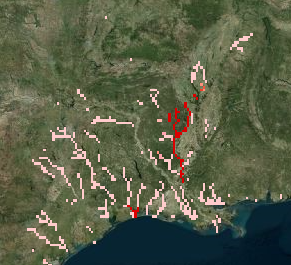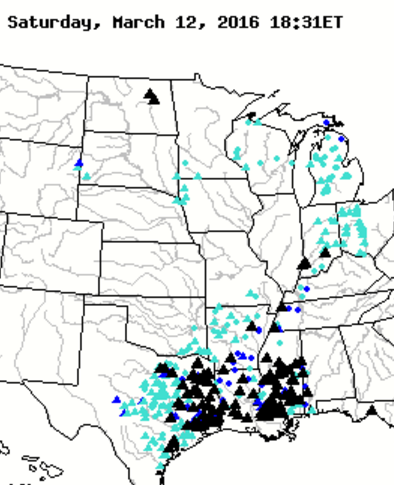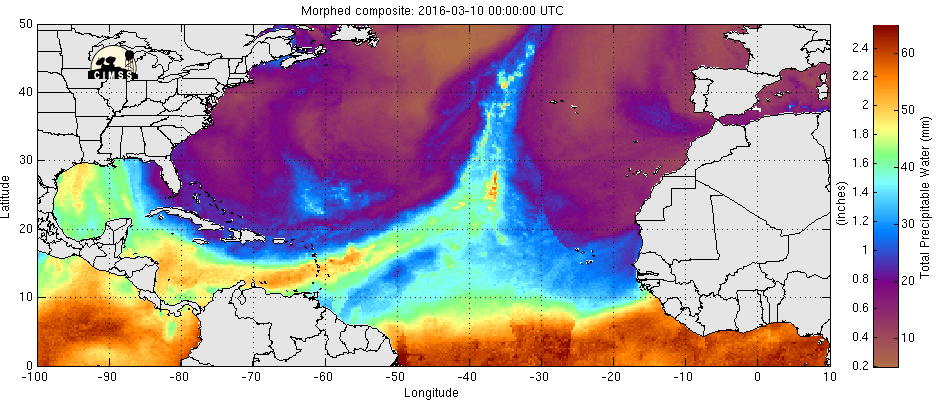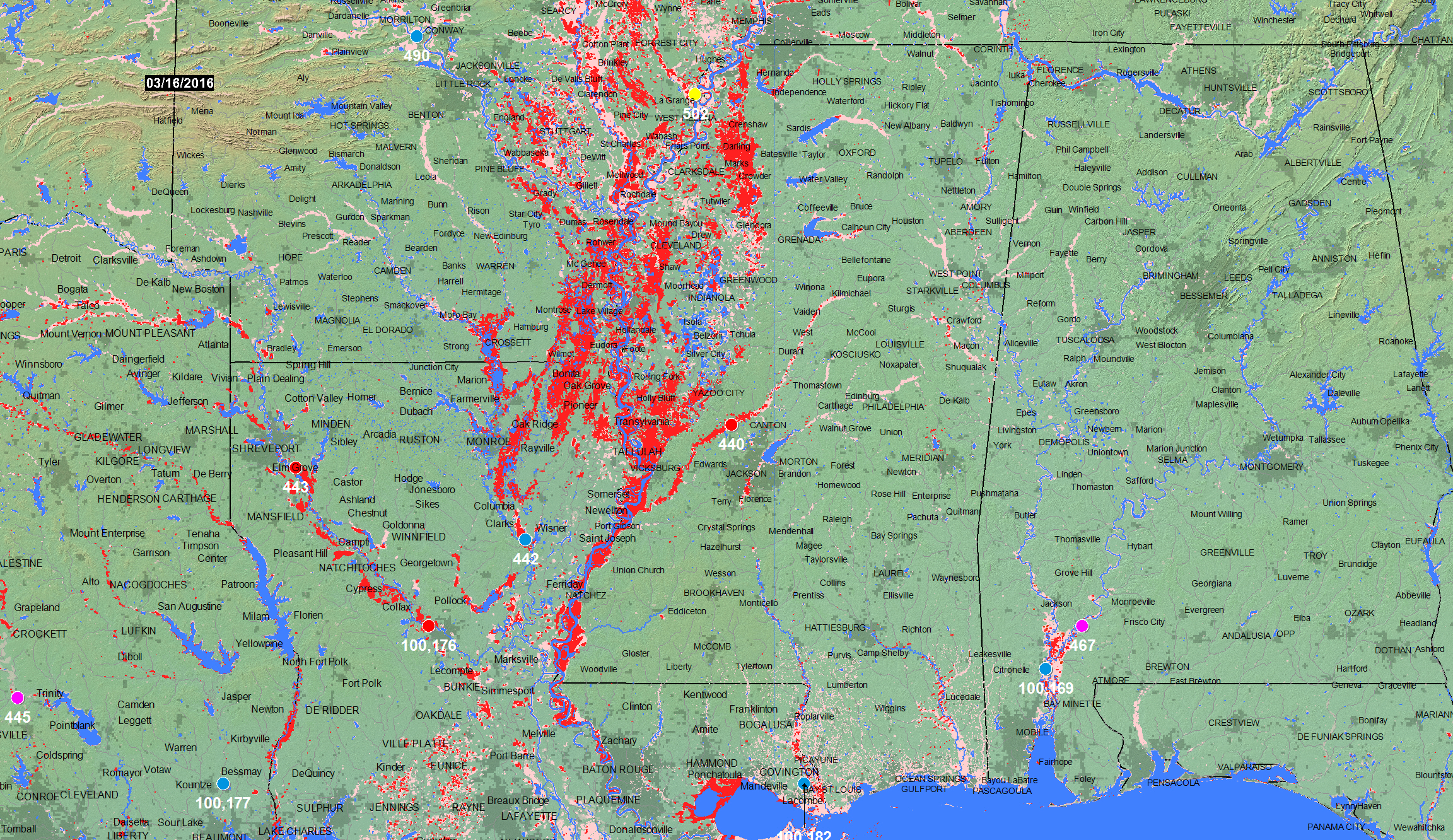





The Flood Observatory maintains a global active archive of large flood events, 1985 to present. It is available to the public in both spreadsheet and GIS formats. New events are entered into this archive each week. As of the end of 2015, there were 4319 events; each has a unique archive number and, starting in 2016, a unique name (example: "2016-Southern USA-4337").
The event information inludes: a polygon outlining the geographic area affected, estimated start and end dates, centroid of the polygon, reported deaths and displaced (occupants of flooded dwellings are included), text location information, causation, and a numerical severity estimate: 1 (relatively frequent but damaging), 1.5 (major), and 2 (extreme). News and other media reports during the flood provide this information; our resources do not permit further evaluation with more accurate data afterwards.
In some cases, large floods then become the focus of Observatory remote sensing data collection and flood inundation mapping. As part of collaborations with other organizations, and the Global Flood Partnership, the Observatory's maps and other data are made available to the public. With appropriate attribution, they can be used freely, including for commercial purposes, under the terms of the Creative Commons Attribution 3.0 Unported License.
This event has been selected for Observatory production of map and GIS data products. Additional event infomation (not produced here) is provided immediately below in the form of images with links to their sources. Please cite the primary source and follow any restrictions provided. New maps and links are added as the event evolves, and the overview map in particular will change as maximum flood extent is imaged and errors are corrected. Afterwards, this web page and associated linked files reside here permanently as the Flood Observatory record of this event.
 |
 |
Gaging stations reporting overbank flow (black triangles) |
7-day Accumulated Rainfall |
 |
 |


Geotif version, March 8, 2016 (pre-flood maximum).
Updated Geotif version, March 24, 2016 (post-flood maximum).
At selected locations, a time series of satellite microwave-based daily river discharge measurements are available from the Flood Observatory. See River Watch Global Display for more information. A sample from Site 443 in this map sheet is shown below. The river reaches monitored by each site are clickable and provide data access. White triangles: ice covered. Yellow dots: low flow (<5th percentile mean for this date, 1998-2012); Blue dots: normal flow; Purple dots: moderate flooding (>1.5 yr recurrence interval); Red dots, major flooding (> 5 yr recurrence interval).

(From higher spatial resolution imaging, when available)
Suggested citation: Brakenridge, G.R., Kettner, A.J., Slayback, D. and Policelli, F., date accessed, "Flood Event 2016-Southern USA-4337", Dartmouth Flood Observatory, University of Colorado, Boulder, Colorado, USA, http://floodobservatory.colorado.edu/Events/2016SouthernUSA4337/2016SouthernUSA4337.html.
To create this display, satellite data are obtained by the Flood Observatory, processed to detect water/land boundaries, and analyzed to produce current surface water extent in vector GIS format. The Observatory also accepts GIS flood inundation limits from other sources and incorporates this information with permission of the authors and as noted when used. The date of last update is shown on the map above; updating ends when the flood begins to decrease in areal extent. A Geotif version is available. Red is current surface water (flooding), where it extends beyond the reference surface water information (Blue). Very light red is all flooding mapped by the Observatory since 1999.
Note: Floods in hilly or mountainous regions are hazardous, but are difficult remote sensing targets and not always observable. Additionally, cloud cover or other constraints sometimes restrict the ability to capture peak inundation everywhere. The displays do not illustrate all areas of possible current flooding. Also, cloud and terrain shadows may be misclassified as flood water. Finally, due to the relatively coarse resolution of the primary data source (MODIS 250 m bands), some areas enclosed as "flooding" may include relatively small parcels of dry land.
Data Sources: The Land Atmosphere Near-real time Capability for EOS (LANCE) system provides daily NASA MODIS data at 250 m spatial resolution. Landsat 8 data, if used, are provided by the U.S. Geological Survey Hazards Data Distribution System. Landsat 8 is jointly managed by NASA and the United States Geological Survey. COSMO-SkyMed synthetic aperture radar (SAR) data are occasionally provided by the Italian Space Agency (ASI) as contribution to the CEOS Flood Pilot. Sentinel 1 SAR data, when used, are provided by the European Space Agency. NASA EO-1satellite tasking and data are provided by Stuart Frye and colleagues at the NASA Goddard Space Flight Center. MODIS data beginning in year 2012 are based on an automated product provided by the MODIS NRT Flood project at the NASA Goddard Space Flight Center. Non-automated, MODIS-based .shp or MapInfo GIS files supporting this Flood Event Map are located in a map sheet folder here together with any other high resolution (using Landsat 8, EO-1, etc) GIS files.Click here for access to the automated daily .shp file GIS record (record commences in 2011). Choose appropriate 10 deg x 10 deg map sheet directory and appropriate dates; longitude and latitudes refere to upper left map sheet corner.
Global Flood Monitoring System (GFMS) data are provided by the University of Maryland. Reference: Wu, H., R. F. Adler, Y. Tian, G. J. Huffman, H. Li, and J. Wang (2014), Real-time global flood estimation using satellite-based precipitation and a coupled land surface and routing model, Water Resour. Res., 50, doi:10.1002/2013WR014710. Global Flood Awareness System (GloFAS) data are provided by the European Commission Joint Research Centre and the European Centre for Medium-Range Weather Forecasts. Reference: Alfieri, L., Burek, P., Dutra, E., Krzeminski, B., Muraro, D., Thielen, J., and Pappenberger, F.: GloFAS – global ensemble streamflow forecasting and flood early warning, Hydrol. Earth Syst. Sci., 17, 1161-1175, doi:10.5194/hess-17-1161-2013, 2013.
(Counting started: March 14, 2016)